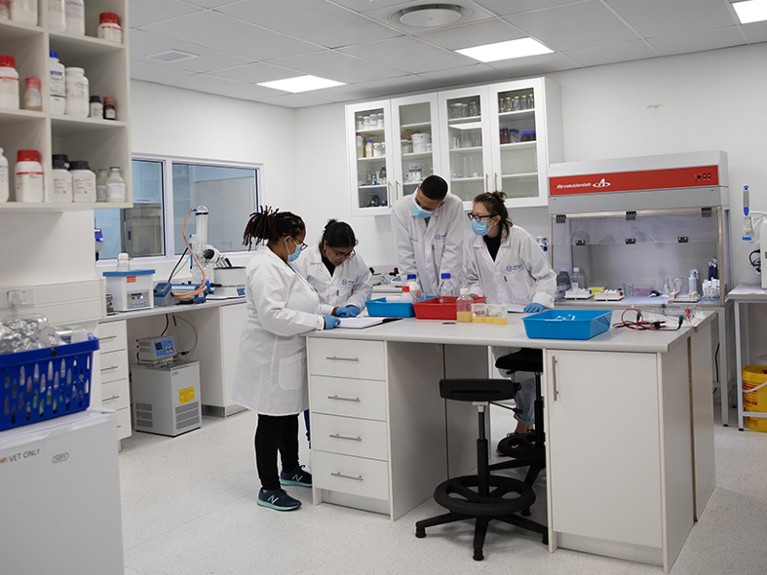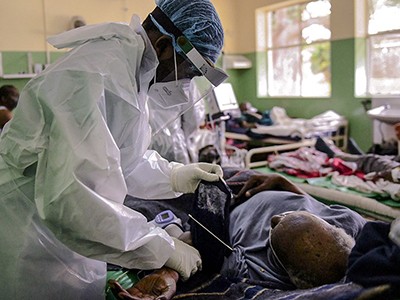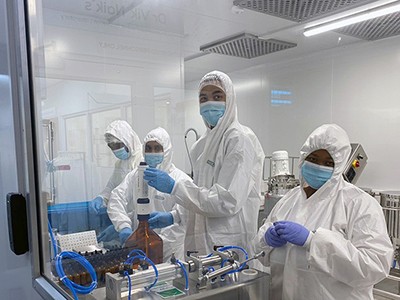
Researchers at Afrigen, based in Cape Town, South Africa. The company has successfully reproduced small quantities of Moderna’s mRNA vaccine.Credit: Samantha Reinders for Nature
Scientists developed vaccines against a new disease in less than 12 months. And yet, 18 months after the first of these vaccines, against COVID-19, were rolled out, just 15% of people in low-income countries have been fully vaccinated. Such inequity costs lives and unmasks a long-standing problem: that some regions of the world have been compelled to rely on others for life-saving science and technology. It is unacceptable, for example, that in Africa, a continent of 54 independent countries and 1.2 billion people, 99% of vaccines are imported.
The World Health Organization (WHO) is searching for a way to get vaccines to more people more efficiently. Last year, the WHO launched a radical initiative called the mRNA vaccine technology transfer hub. The aim of the initiative is to set up a system that develops and produces mRNA vaccines and treatments (for COVID-19 and other diseases) from the technology used in Pfizer and Moderna’s highly successful COVID-19 vaccines.
Crucially, the ambition is to achieve this through collaborations between universities and companies based in low- and middle-income countries. In a significant move, on 8 July, the US National Institutes of Health, where much of the foundational research on mRNA vaccines was conducted, joined this mission to build capacity in lower-income countries.
Unseating big pharma: the radical plan for vaccine equity
However, as Nature reports in a Feature, the hub must overcome challenges presented by the global vaccine market, world trade rules and an intellectual-property (IP) system that often benefits established corporations, universities and governments in high-income countries.
One hurdle will be convincing governments and organizations to buy locally made vaccines: such products might initially cost more than those made by established companies that produce at larger scales and can afford to drop prices. But for this initiative to be viable over time, local manufacturers of mRNA vaccines and therapeutics need to be assured that there will be demand for their products. For this to happen, up-front contracts will be needed from buyers.
A key buyer is Gavi, the Vaccine Alliance, a public–private global health partnership that procures vaccines for dozens of lower-income countries, funded largely by high-income countries and the Bill & Melinda Gates Foundation, a non-profit organization based in Seattle, Washington. Gavi has said that it is committed to supporting vaccine manufacturing in Africa; however, it has not specified how much extra money it would spend on regionally made vaccines, and it has not yet promised to buy vaccines from the companies working with the mRNA technology transfer hub.
In May, the leaders of a number of African Union (AU) member states called on Gavi to commit to buying at least 30% of all COVID-19 vaccines produced in Africa as new manufacturers come online. Such a commitment will be essential to reaching the AU’s ambition for 60% of Africa’s vaccines to be produced on the continent by 2040.
Adjusting the scales
Barriers created by IP rights represent yet another hurdle in the hub’s path. Earlier this year, the company at the core of the hub, Afrigen Biologics and Vaccines in Cape Town, South Africa, successfully reproduced small quantities of Moderna’s mRNA vaccine. But Moderna has not agreed to license its IP or share data that could help Afrigen to ensure that its vaccine candidate meets similar safety and efficacy metrics.
South African scientists copy Moderna’s COVID vaccine
Sadly, last month, the World Trade Organization (WTO) ended some 20 months of negotiations on a waiver proposed by South Africa and India covering IP on COVID-19 vaccines, drugs and diagnostic tests, which would have allowed faster knowledge sharing. The campaign, which Nature supported, faced strong opposition from the European Union and the pharmaceutical industry.
The WTO members instead agreed on a deal to amend existing rules on IP sharing in emergencies; however, these will be cumbersome to implement and do not amount to a waiver. Many researchers who have devoted their careers to studying mRNA want to see it save more lives, rather than widen inequality, and question whether the current IP regime is, in fact, stifling the kind of innovation that could see the mRNA hub succeed.
The hub is a refreshing, ambitious alternative to the existing model for vaccine research and development (R&D). With collaboration and knowledge sharing at its core, it aims to create and boost home-grown R&D and innovation in low- and middle-income countries. But it is clearly a threat to a system in which companies are able to claim IP rights on lifesaving products that are often created using findings from publicly funded research.
As economists Mariana Mazzucato and Jayati Ghosh, with innovation-policy researcher Els Torreele, have argued, there is something wrong with a system in which people’s taxes pay for science, yet, in the middle of a pandemic, relatively few companies and governments are permitted to control who has access to lifesaving products derived from research, and on what terms (see go.nature.com/3ixz3dd).
The WHO and its partners are right to seek to adjust the scales. In addition to the justice imperative, outbreaks would end sooner if every region of the world could rely on its own defences, stifling the spread of emerging pathogens and viral variants. As Larry Brilliant, an epidemiologist who helped to eradicate smallpox, told Nature: “Equity is often thought of as a burden, but it is a strategic need in the battle against pandemics.”

 Unseating big pharma: the radical plan for vaccine equity
Unseating big pharma: the radical plan for vaccine equity
 South African scientists copy Moderna’s COVID vaccine
South African scientists copy Moderna’s COVID vaccine
 Time is running out for COVID vaccine patent waivers
Time is running out for COVID vaccine patent waivers
 How COVID spurred Africa to plot a vaccines revolution
How COVID spurred Africa to plot a vaccines revolution






